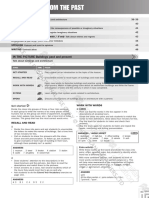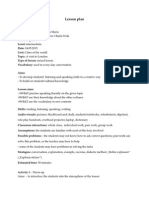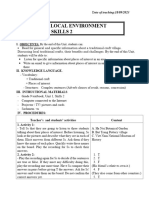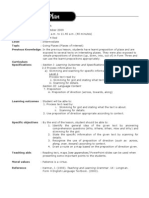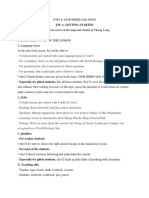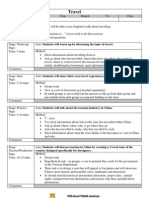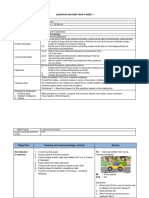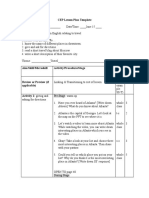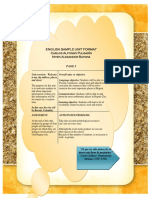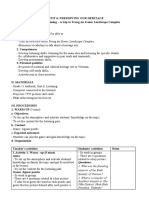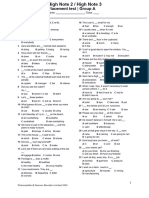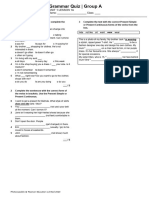TESOL Core Certificate Program, Part 2
Teaching Adult Learners
Module 3 Culminating Task
Annotated Sample Reading Lesson
Type of Class: EFL , Korean Speakers Level: Time period:
Topic: Tourism, Community Intermediate 2 hours Comment: Sufficient time for this lesson
Lesson Objective: By the end of the lesson students will be able to read adapted articles on
places to visit in Seoul and determine which places are the most entertaining, which are the most
educational, and which are the least expensive in order to make recommendations to tourists. Comment: Context: Tourism, Proficiency:
R (with Speaking integrated)
Target Vocabulary: (general) site, fee, attraction, tour, architecture
Communication Task: Read for
Sample article: destroy, reconstruct, survive, grounds (other vocabulary based on other articles) Information, Make recommendations
Stage Activity Resources Assess-ability: Comp Questions, Task
1. Tell a short story about my weekend going to a few places Text sources Comment: Manageable amount of
in the city—some great, some not-so great. http://english.vi vocabulary
2. Have groups of students brainstorm a list of places they sitkorea.or.kr/en
like to go and then share two items from each list. u/SI/SI_EN_3_
3. Ask Ss if people ever ask them about good places to 1_1_1.jsp?cid=2
relax, eat, visit, etc. go. 64337S Comment: Engage learners’ prior
4. Tell students they will be investigating* places to go in the Also knowledge, build learner schema
INTO city using information from articles they find on the Net. Seoul: 10 (background knowledge)
Put up chart (see attached) to show students the task the Things to Do in
24 Hours
information they will have by the end of the lesson. Comment: Purpose in reading
http://www.time.
5. Put a list of 10 words from the sample article (some new, com/time/travel/ established
some known) on the board and have students ID those cityguide/article/
words they already know, those their teammates know 0,31489,184837
and those they have to look up. Review with the class. 8_1848364_184 Comment: Front-loading essential
6. Put up picture of Gyeongbok Palace and ask Ss to tell you 7897,00.html vocabulary; work with social strategy
everything they see in the picture and what they know
about the site. Technology: Comment: Pre-reading, schema building
7. Distribute the reading on the Palace and have students Learners may
scan the reading for the target vocabulary words, putting a choose to look Comment: Reading skill development:
dot next to each. Have partners check to be sure all the up additional scanning
words are found. info on the Net
8. Have students read the article once silently. Visuals: Comment: Effective reading instruction
9. Put up 5 comprehension questions about the text. Have pictures from
THROUGH Net
students read the article again and underline the answers
in the text. Pair students and have them compare their
answers. Other: Sample Comment: Learner-centered practice
10. Read the article aloud as students read silently. Do “think chart, reading,
aloud” moments, e.g.. —“OH there’s the answer to vocabulary Comment: Modeling “while”reading
question #1, etc. “ worksheet, strategy.
10. Group students in trios and explain the task: and list of sites
• select a location from a list on the board. on the board
• pick up the article on the selected location. with links
• have groups scan their article for the necessary
information *Note, I’ll need
• complete their version of the chart. to preview Comment: Task requires application and
BEYOND
11. Check comprehension of the task and set a time limit. articles expansion of reading skills developed and
12. Groups do the task then plan report back deciding whether integrates speaking and listening .
to recommend the site or not and why.
13. Groups report back and put their information in a large
class chart. Comment: Product that class can later
use for a form-focus work on
Evaluation of reading comprehension occurs during the recommendations or comparisons.
comprehension check in step 8 and evaluation of objective Comment: There is one text-based
EVALUATION
occurs during observation in step 12 and the report back in evaluation and one performance-based
step 13. evaluation (the report back)
CLASS CHART (Each group will get a truncated version with only one row to fill in. )
�T&AAL FALL 2012 • Module 3- Culminating Task: ANNOTATED READING LESSON
Attraction Fee? Tours? Hours Recommended?
and Features
Location Yes No ? Yes No ? Educational? Entertaining? Inexpensive?
Adapted reading passage
Introduction
Gyeongbokgung Palace was built in 1395. It is also referred to as the
“Northern Palace” because it is the furthest north when compared to its
neighbors Changdeokgung (Eastern Palace) and Gyeongheegung
(Western Palace). Many people believe that Gyeongbokgung Palace is
the most beautiful and grandest of all five palaces.
The Palace was destroyed by fire during the Imjinwaeran War (Japanese
Invasion, 1592-1598). However, Heungseondaewongun reconstructed
all of the palace's 7,700 rooms during the reign of King Gojong (1852-
1919) .
Much of the architecture of the original palace survived the fire and
sculptures on the palace grounds represent the contemporary art of the
15th century.
The Palace is open from 9:00-18:00 in March through October and
closes one hour earlier in November through February. It’s closed on
Tuesdays. Tickets for adults are 3,000 won and children’s tickets are
1,500 won.
There is a discount for groups over 10. Tours in English are also
available and depart from the Information Center at Heungnyemun
Gate
* Reservations are required for groups of 10 or more.
Directions
Gyeongbokgung Palace Station (Seoul Subway Line 3), Exit 5.
OR,
Gwanghwamun Station (Seoul Subway Line 5), Exit 2.





